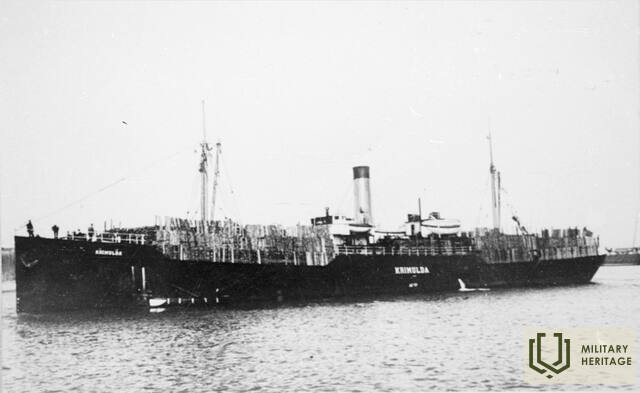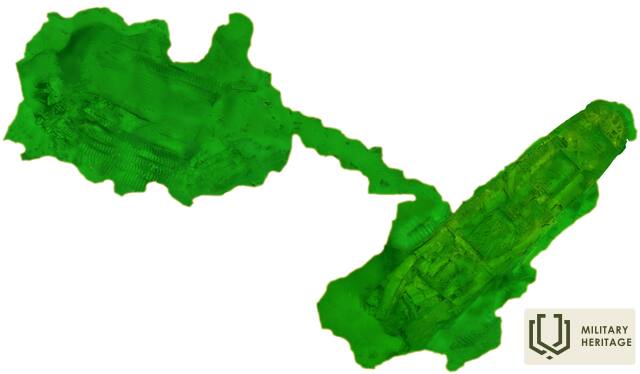Krovininis garlaivis „Krimulda“ Karinė įranga


Pastatytas 1899 m. Blyte, Anglijoje. Laivo matmenys: 83,82 x 12,192 x 5,52 metro. Vienas denis, du stiebai.
Iš pradžių vadinosi „Somerford“, priklausė „Speeding & Marshall SS Co.“. Nuo 1910 m. pavadinimas – generolas Dragomirovas, o savininkas – „Gebrüder Seeberg“ Rygoje.
Pirmojo pasaulinio karo metu, 1915 m. gruodžio 3 d., laivas buvo priimtas į Baltijos laivyno tarnybą. Nuo 1917 m. spalio 25 d. priklausė bolševikams. 1918 m. pavadinimas buvo „Komissar“ (laivybos kompanija „Transbalt“). Nuo 1920 m. pavadinimas buvo „Krimulda“, o pagal taikos sutartį 1920 m. gruodžio 17 d. buvo grąžintas buvusiam savininkui „Gebrüder Seeberg“.
Antrojo pasaulinio karo įvykiai ir politiniai pokyčiai atnešė tragiškų pasekmių Baltijos šalių jūrų laivybai, kurios paveikė tiek laivų, tiek jūrų sektoriuje dirbančių žmonių likimus.
1940 m. birželio 9 d. Sovietų Sąjungos karinio jūrų laivyno Baltijos laivyno vadui viceadmirolui Vladimirui Tribucui buvo įsakyta pavaldyti laivyną Leningrado karinės apygardos vadui ir būti pasiruošusiam vykdyti jo duotus kovinius įsakymus. Pagrindinės užduotys buvo užgrobti visus Estijos, Latvijos ir Lietuvos jūrų laivus, nutraukti jūrų susisiekimą tarp šių šalių, uždaryti Rygos įlanką ir užblokuoti Estijos ir Latvijos pakrantes, siekiant užkirsti kelią šių šalių vyriausybių evakuacijai. 1941 m. birželio 22 d. tarp hitlerinės Vokietijos ir stalininės Rusijos kilo karas, kuris pirmiausia pasireiškė Baltijos šalyse jūrų ir oro karo pavidalu.
Įsakymas evakuoti Rusijos pajėgas buvo gautas birželio 27 d. Tos pačios dienos vakare Baltijos laivynas, įskaitant krovininį garlaivį „Krimulda“, išplaukė iš Ventspilio, plaukdamas Didžiuoju sąsiauriu ir Pernu. Birželio 28 d. laivai inkaravosi ir tęsė kelionę tik birželio 29 d. vidurdienį. Birželio 30 d. laivai vėl buvo išmetę inkarus. Liepos 1 d. vakare kapitonas gavo įsakymą plaukti į Leningradą.
Liepos 1 d., perplaukusi sąsiaurį, „Krimulda“ netoli Vormsi užvažiavo už minos ir nuskendo. Žuvo penki jūreiviai. Likusi komandos dalis įlipo į dvi gelbėjimo valtis ir patraukė Vormso švyturio link, o nuo kranto atplaukęs motorlaivis pabėgusius jūreivius nutempė į Rohukülą.
„Krimulda“ buvo apšaudyta netoli laivapriekio stiebo, o laivapriekis atsiskyrė nuo korpuso. Todėl laivapriekis yra gana sudaužytas, o laivagalis – gana gerai išsilaikęs. „Krimulda“ nuolaužos guli 16 metrų gylyje. Laivapriekio detalės yra maždaug 25 metrus į rytus nuo šiaurės-pietų kryptimi nukreipto laivagalio. Laivagalis guli ant kilio, denyje matyti atsarginiai sraigtai ir gervės kroviniams krauti, o triumuose – daug medienos.
Panaudoti šaltiniai ir literatūra:
Estijos istorija VI. 2005. Illamaa.
Miklāvs 1991. Garlaivio "Krimulda" skęstimas - Maija Frīdberga. Latvijos jūrų metraštis '91. Ryga, 64-67.







